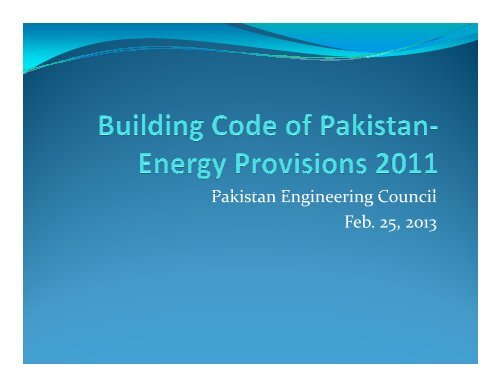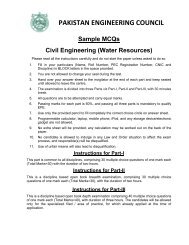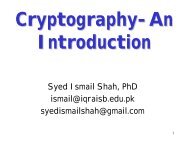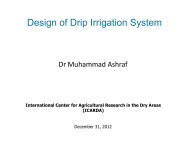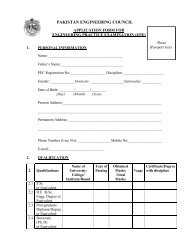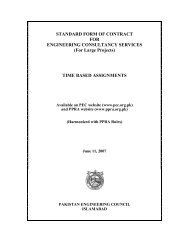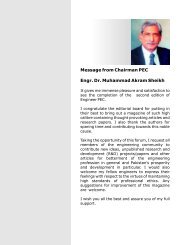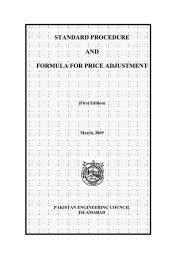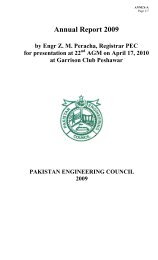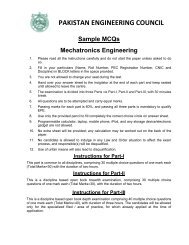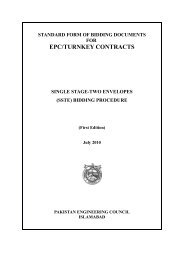PEC building energy code - Pakistan Engineering Council
PEC building energy code - Pakistan Engineering Council
PEC building energy code - Pakistan Engineering Council
You also want an ePaper? Increase the reach of your titles
YUMPU automatically turns print PDFs into web optimized ePapers that Google loves.
<strong>Pakistan</strong> <strong>Engineering</strong> <strong>Council</strong><br />
Feb. 25, 2013
Scope<br />
These Provisions shall apply to <strong>building</strong>s and <strong>building</strong><br />
clusters that have: a total connected load of 100 kW or<br />
greater, or a contract demand of 125 kVA or greater, or a<br />
conditioned area of 900 m 2 or greater, or unconditioned<br />
<strong>building</strong>s of covered area of 1,200 m 2 or more.
The scope of the Energy Provisions is applicable to the<br />
following to provide minimum <strong>energy</strong>-efficient<br />
requirements for the design and construction of:<br />
1. new <strong>building</strong>s and their systems<br />
2. new portions of existing <strong>building</strong>s and their systems, if<br />
the conditioned area or connected load exceeds the<br />
prescribed above<br />
3. new systems and new equipment in existing <strong>building</strong>s,<br />
and<br />
4. increase in the electricity load beyond the minimum<br />
exemption limit
Applicable Building Systems<br />
The Energy Provisions shall apply to the following:<br />
Building envelopes (Section 4),<br />
HVAC equipment (Section 5)<br />
Service water heating (Section 6),<br />
<br />
Lighting (Section 7), and<br />
Electrical power and motors (Section 8)
Exemptions<br />
The Energy Provisions shall not apply to the following:<br />
Buildings that do not use either electricity or fossil<br />
fuel,<br />
Government notified historically significant and<br />
heritage <strong>building</strong>s,<br />
Equipment and portions of <strong>building</strong> systems that use<br />
<strong>energy</strong> only for manufacturing processes.
New Buildings<br />
New <strong>building</strong>s shall comply with the provisions of<br />
Sections 4 through 8.<br />
Alterations to Existing Buildings:<br />
Alterations to existing <strong>building</strong>s and <strong>building</strong> systems<br />
shall comply with the Energy Provisions-2011of Sections<br />
4 through 8<br />
Building Envelope<br />
Alterations to the <strong>building</strong> envelope shall comply with<br />
the requirements of Section
BUILDING ENVELOPE<br />
Introduction<br />
Building Envelope<br />
External Walls and Roofs<br />
Glass and Framing System<br />
Air Leakage/ Infiltration
BUILDING ENVELOPE<br />
General<br />
The criteria set in this section establish the minimum<br />
<strong>energy</strong> conservation and efficiency requirements for the<br />
<strong>building</strong> envelope.<br />
Building Envelope<br />
The design of <strong>building</strong>s, and selection of materials<br />
forming their surfaces, shall aim at reducing heat transfer<br />
to and from <strong>building</strong>s and adhere to the following criteria.
External Walls and Roofs<br />
Overall U values of external walls and roofs shall not<br />
exceed limits specified in Table<br />
Wall U: 0.57 W/m 2 .K (0.100 Btu/h.ft 2 . o F)<br />
Roof U: 0.44 W/m 2 .K (0.078 Btu/h.ft 2 . o F)
Glass and Framing System<br />
For <strong>building</strong>s with external glass area, not exceeding<br />
40% of the external wall area of the <strong>building</strong>, the overall<br />
U values and shading coefficient shall not exceed limits<br />
specified in Table .<br />
Heat Transmission<br />
Coefficient (U):<br />
3.5 W/m 2 .K (0.44 Btu/h.ft 2 . o F)<br />
Shading Coefficient (SC): 0.76
Glass and Framing System<br />
For <strong>building</strong>s with external glass area, in excess of 40%<br />
of the external wall area of the <strong>building</strong>, the overall U<br />
values and shading coefficient shall not exceed limits<br />
specified in Table.<br />
Heat Transmission Coefficient (U): 2.5 W/m 2 .K (0.37 Btu/h.ft 2 . o F)<br />
Shading Coefficient (SC): 0.35
Air Leakage/Infiltration<br />
The <strong>building</strong> envelope shall be durably sealed, caulked,<br />
gasketed, or weather-stripped to minimize air leakages<br />
wherever the tendency exits.<br />
Vestibules/ lounges/ entrances shall be provided to<br />
minimize infiltration through revolving/sliding/swinging<br />
doors.<br />
Air leakages for revolving/ sliding/ swinging entrance/exit<br />
doors shall not exceed 1.0 cfm/ft 2 and for windows, doors<br />
air leakage shall not exceed 0.4 cfm/ft 2 .
Heating, Ventilation and Air Conditioning<br />
Controls<br />
Dead Band<br />
Mechanical Ventilation<br />
Non- Residential Kitchen Space<br />
Cooling Towers<br />
Piping and Ductwork<br />
System Balancing<br />
Condenser<br />
Minimum Equipment Efficiencies<br />
Economizers<br />
Hydronic Variable Flow Systems
Heating, Ventilation and Air Conditioning<br />
Alterations to <strong>building</strong> heating, ventilation and air<br />
conditioning equipment or systems shall comply with<br />
the requirements of Section- 5.<br />
Any new equipment or control devices/systems installed<br />
Any new equipment or control devices/systems installed<br />
in conjunction with the alteration shall comply with the<br />
specific minimum efficiency requirements applicable to<br />
that equipment or control device/system provided.
HEATING, VENTILATION AND AIR CONDITIONING<br />
Controls<br />
System Control<br />
All mechanical cooling and heating systems shall be<br />
controlled by a <strong>building</strong> management system or a time<br />
clock that:<br />
a) can start and stop the system under different schedules<br />
for three different day types per week,<br />
b) is capable of retaining programming and time setting<br />
during a loss of power for a period of at least 10 hours,<br />
and Includes an accessible manual override that allows<br />
temporary operation of the system for up to 2 hours.<br />
Exceptions: Residential sector with non centralized<br />
system/s
Temperature Control<br />
Temperature to be maintained as follows:<br />
Summer: not less than 25 o C<br />
Winter: not more than 22 o C
Dead Band<br />
All heating and cooling equipment shall be temperature<br />
controlled.<br />
Where a unit provides both heating and cooling, controls<br />
shall be capable of providing a temperature dead band of<br />
3°C within which the supply of heating and cooling<br />
<strong>energy</strong> to the zone is shut off or reduced to a minimum.<br />
Where separate heating and cooling equipment serve the<br />
same temperature zone, thermostats shall be interlocked<br />
to prevent simultaneous heating and cooling.
Exceptions:<br />
<br />
<br />
Thermostats that require manual changeover<br />
between heating and cooling modes.<br />
Special occupancy or special applications where wide<br />
temperature ranges are not acceptable
Mechanical Ventilation<br />
Each mechanical ventilation system shall be equipped<br />
with a readily accessible switch or other means for shut<br />
off or for volume reduction or shut off when full<br />
ventilation is not required.<br />
Automatic or gravity dampers that close when the<br />
system is not operating shall be provided for outdoor<br />
air intake and exhausts.<br />
Automatic or manual dampers installed for the<br />
purpose of shutting off ventilation systems shall be<br />
designed with tight shutoff characteristics to minimize<br />
air leakage.
Exceptions: Manual dampers for outdoor intakes may<br />
be used in the following cases:<br />
For family residential <strong>building</strong>s<br />
Dampers are not required when ventilation air flow is<br />
less than 100 ft³/min
Non- Residential Kitchen Space<br />
Non-residential kitchen space shall be designed with an<br />
exhaust air and make up air balance such that the space<br />
is never under a positive pressure with reference to<br />
adjacent space.
Cooling Towers<br />
All cooling towers and closed circuit fluid coolers shall<br />
have preferably variable drives either two speed motors<br />
or pony motors, controlling the fans.
Piping and Ductwork<br />
Piping shall be insulated in accordance with table:<br />
Fluid Design<br />
Operation<br />
Temp. Range<br />
( o F)<br />
Insulation Conductivity<br />
Nominal Pipe or Tube Size<br />
(in.)<br />
Mean<br />
1-<br />
Conductivity Rating 1 to 1/2<br />
Btu. in./ Temp. < 1- to<br />
(h.ft 2 . o F)<br />
o F 350 0.32 - 0.34 250 2.5 3.0 3.0 4.0 4.0<br />
251 – 350 0.29 – 0.32 200 1.5 2.5 3.0 3.0 3.0<br />
201 – 250 0.27 – 0.30 150 1.5 1.5 2.0 2.0 2.0<br />
141 – 200 0.25 – 0.29 125 1.0 1.0 1.0 1.5 1.5<br />
105 – 140 0.22 – 0.28 100 0.5 0.5 1.0 1.0 1.0<br />
Domestic and Service Hot Water Systems<br />
105+ 0.22 – 0.28 100 0.5 0.5 1.0 1.0 1.0<br />
Cooling Systems (Chilled Water, Brine, and Refrigerant)<br />
40 – 46 0.22 – 0.28 100 0.5 0.5 1.0 1.0 1.0<br />
< 40 0.22 – 0.28 100 0.5 1.0 1.0 1.0 1.5
Minimum Duct Insulation R-Value a , Combined<br />
Heating and Cooling Supply Ducts and Return<br />
Ducts<br />
Duct Locations<br />
Exterior Ventilated Unvented<br />
Attic with<br />
Un-vented<br />
Buried<br />
Attic<br />
Attic Roof<br />
above Insulation<br />
Unconditioned Space b<br />
a<br />
Insulated<br />
Ceiling<br />
Supply Ducts<br />
R-6 R-6 R-8 R-3.5 R-3.5 R-3.5<br />
Return Ducts<br />
R-3.5 R-3.5 R-3.5 None none None<br />
a Insulation R-value, measured in (h. ft 2 . 0 F)/Btu, is<br />
measured on a horizontal plane in accordance with ASTM<br />
C518 at a mean temperature of 75 0 F at the installed<br />
thickness.
System Balancing<br />
Construction documents shall require that all HVAC<br />
systems be balanced in accordance with generally<br />
accepted engineering standards.<br />
Construction documents shall require that a written<br />
testing, commissioning and balance report be provided<br />
to the owner or the designated representative of the<br />
<strong>building</strong> owner for HVAC systems serving zones with a<br />
total conditioned area exceeding 5000m 2 .
Air System Balancing<br />
Air systems shall be balanced in a manner to first<br />
minimize throttling losses<br />
Then, for fans with fan system power greater than 1.0 hp,<br />
fan speed shall be adjusted to meet design flow<br />
conditions.<br />
Hydronic System Balancing<br />
Hydronic systems shall be proportionately balanced in a<br />
manner to first minimize throttling losses<br />
Then the pump impeller shall be trimmed or pump<br />
speed shall be adjusted to meet design flow conditions.
Exceptions:Impellers need not be trimmed nor pump<br />
speed adjusted:<br />
For pumps with pump motors of 10 hp or less,<br />
When throttling results in no greater than 5% of the<br />
When throttling results in no greater than 5% of the<br />
nameplate horsepower draw, or 3 hp, whichever is<br />
greater, above that required if the impeller to be<br />
trimmed.
Condenser<br />
Condenser Location<br />
Care shall be exercised in locating the condenser in such<br />
a manner that heat sink is free of interference from heat<br />
discharge by devices located in adjoining spaces and also<br />
does not interfere with such other systems installed<br />
nearby.<br />
Treated Water for Condenser<br />
All <strong>building</strong>s using centralized cooling water system<br />
shall use soft water for the condenser and chilled water<br />
system.
Minimum Equipment Efficiencies<br />
HVAC Equipment shall meet or exceed the minimum<br />
performance at the specified rating conditions when<br />
tested in accordance with the specified test procedures.
Table: Air Conditioners and Condensing Units<br />
Equipment<br />
Type<br />
Size Category<br />
Heating<br />
Section Type<br />
Sub-Category<br />
or<br />
Rating<br />
Condition<br />
Minimum<br />
Efficiency a<br />
Test<br />
Procedure b<br />
Air Conditioners,<br />
Air Cooled<br />
65,000 Btu/h<br />
and<br />
< 135,000 Btu/h<br />
> 135,000 Btu/h<br />
and<br />
< 240,000 Btu/h<br />
> 240,000 Btu/h<br />
and<br />
< 760,000 Btu/h<br />
> 760,000 Btu/h<br />
Electric<br />
Resistance<br />
(or None)<br />
All other<br />
Electric<br />
Resistance<br />
(or None)<br />
All other<br />
Electric<br />
Resistance<br />
(or None)<br />
All other<br />
Electric<br />
Resistance<br />
(or None)<br />
All other<br />
Split System<br />
and<br />
Single Package<br />
Split System<br />
and<br />
Single Package<br />
Split System<br />
and<br />
Single Package<br />
Split System<br />
and<br />
Single Package<br />
Split System<br />
and<br />
Single Package<br />
Split System<br />
and<br />
Single Package<br />
Split System<br />
and<br />
Single Package<br />
Split System<br />
and<br />
Single Package<br />
10.3 EER<br />
10.1 EER<br />
9.7 EER<br />
9.5 EER<br />
9.5 EER<br />
9.7 IPLV<br />
9.3 EER<br />
9.5 IPLV<br />
9.2 EER<br />
9.4 IPLV<br />
9.0 EER<br />
9.2 IPLV<br />
ARI<br />
340/360
Equipment<br />
Type<br />
Size Category<br />
Heating<br />
Section Type<br />
Sub-Category<br />
or<br />
Rating<br />
Condition<br />
Minimum<br />
Efficiency a<br />
Test<br />
Procedure b<br />
< 65,000 Btu/h All<br />
Split System and<br />
Single Package<br />
12.1<br />
EER<br />
ARI<br />
210/240<br />
> 65,000 Btu/h and<br />
135,000 Btu/h<br />
and<br />
240,000 Btu/h<br />
Electric<br />
Resistance<br />
(or None)<br />
All other<br />
Split System and<br />
Single Package<br />
Split System and<br />
Single Package<br />
1 1.0<br />
EER<br />
10.3<br />
IPLV<br />
10.8<br />
EER<br />
10.1<br />
IPLV<br />
Condensing Units,<br />
Air Cooled > 135,000 Btu/h<br />
Condensing Units,<br />
Water or<br />
Evaporatively Cooled<br />
> 135,000 Btu/h<br />
10.1<br />
EER<br />
11.2<br />
IPLV<br />
13.1<br />
EER<br />
13.1<br />
IPLV<br />
ARI 365
a PLVs and part load rating conditions are only applicable to<br />
equipment with capacity modulation.<br />
b ASHRAE 90.1-2004 contains a complete specification of the<br />
referenced test procedure, including the referenced year<br />
version of the test procedure.<br />
c Single-phase, air-cooled air-conditioners < 65,000 Btu/h<br />
are regulated by NAECA. SEER values are those set by<br />
NAECA.
Table: Water Chilling Packages Minimum Efficiency<br />
Requirements<br />
Equipment Type<br />
Air Cooled<br />
Water Cooled,<br />
Electrically Operated,<br />
(Reciprocating)<br />
Size Category<br />
All Capacities<br />
All Capacities<br />
Minimum<br />
Efficiency a<br />
2.80 COP<br />
3.05 IPLV<br />
4.20 COP<br />
5.05 IPLV<br />
b<br />
Test Procedure<br />
ARl550/590<br />
ARl550/590<br />
Water Cooled,<br />
Electrically Operated,<br />
(Rotary Screw and<br />
Scroll)<br />
150 tons and<br />
300 tons<br />
5.50 COP<br />
6.15 IPLV<br />
150 tons and<br />
300 tons<br />
All Capacities<br />
All Capacities<br />
All Capacities<br />
6.10 COP<br />
6.40 IPLV<br />
0.7 COP<br />
1.00 COP<br />
1.05 IPLV<br />
1.00 COP<br />
1.00 IPLV<br />
ARl550/590
a The chiller equipment requirements do not apply<br />
for chillers used in low-temperature applications<br />
where the design leaving fluid temperature is<br />
< 40 0 F.<br />
b ASHRAE 90.1-2004 contains a complete<br />
specification of the referenced test procedure,<br />
including the referenced year version of the test<br />
procedure.
Warm Air Furnaces and Combination Warm Air<br />
Equipment<br />
Type<br />
Warm Air<br />
Furnace,<br />
Gas-Fired<br />
Size Category<br />
(Input)<br />
225,000 Btu/h 80% E c ANSI Z21.47<br />
Warm air<br />
Furnace,<br />
Oil-Fired<br />
225,000 Btu/h 81%E t UL 727
a E t = thermal efficiency.<br />
b ASHRAE 90.1-2004 contains a complete specification of the referenced<br />
test procedure, including the referenced year version of the test<br />
procedure.<br />
c E c = combustion efficiency. Units must also include an interrupted or<br />
intermittent ignition device , have jacket losses not exceeding 0.75% of<br />
the input rating, and have either power venting or a flue damper.<br />
d Combination units not covered by NAECA (3-phase power or cooling<br />
capacity greater than or equal to 65,000 Btu/h) may comply with either<br />
rating.<br />
e Minimum and maximum ratings as provided for and allowed by the<br />
unit's controls.<br />
f E t is thermal efficiency. Units must also include an interrupted or<br />
intermittent ignition device (IID), have jacket losses not exceeding<br />
0.75% of the input rating, and have either power venting or a flue<br />
damper. A vent damper is an acceptable alternative to a flue damper for<br />
those furnaces where combustion air is drawn from the conditioned<br />
space.<br />
g E c = combustion efficiency.
Economizers<br />
Air Side Economizer<br />
Each individual cooling fan system that has a design<br />
supply capacity over 2,500 cfm and a total mechanical<br />
cooling capacity over 75,600 Btu/hr (6.3 tons) shall<br />
include either:<br />
a) An air economizer capable of modulating outsideair<br />
and return-air dampers to supply 100 percent of the<br />
design supply air quantity as outside-air; or<br />
b) A water economizer capable of providing 100% of<br />
the expected system cooling load at outside air<br />
temperatures of 50°F (10°C) dry-bulb/45°F (7.2°C) wetbulb<br />
and below.
Testing Air Side Economizer<br />
Air-side economizers shall be tested in the field to<br />
ensure proper operation.<br />
Exception:<br />
Air economizers installed by the HVAC system<br />
equipment manufacturer and certified to the <strong>building</strong><br />
department as being factory calibrated and tested per<br />
relevant ASHRE/ARI Standard procedures.
Hydronic Variable Flow Systems<br />
HVAC pumping systems that include control valves shall be<br />
designed for variable fluid flow and shall be capable of<br />
reducing pump flow rates to:<br />
(a) 50% of the design flow rate, or<br />
(b) less of the design flow rates for proper operation of<br />
the chillers or boilers.
Water cooled air-conditioning or heat pump units with a<br />
circulation pump motor greater than or equal to 5 hp<br />
shall have control devices on each water cooled airconditioning<br />
or heat pump unit that are interlocked with<br />
the compressor to shut off condenser water flow when<br />
the compressor is not operating.<br />
Chilled water or condenser water systems that have<br />
pump motors greater than or equal to 5 hp (3.7kW) shall<br />
be controlled by variable speed drives.
Recommended Voluntary Adoption<br />
Natural Ventilation<br />
Natural ventilation shall comply with the design<br />
guidelines as per ASHRAE.<br />
Alternate Energy<br />
The use of <strong>energy</strong> recovery system, geothermal <strong>energy</strong>,<br />
solar systems and other renewable <strong>energy</strong> systems is<br />
encouraged for adoption in <strong>building</strong>s as an alternative to<br />
conventional heating, ventilating and cooling systems.
SERVICE WATER HEATING<br />
Piping Insulation<br />
Equipment Efficiency<br />
Swimming Pools
Piping Insulation<br />
Piping insulation shall comply with Table :<br />
Fluid Design Operating Insulation Conductivity<br />
Nominal Pipe or Tube Size (In.)<br />
Temp. Range (ºF) Conductivity<br />
Btu. in./ Mean Rating<br />
1-1/2 4 to<br />
(h.ft 2 .ºF)<br />
Temp. ºF 350 0.32 – 0.34 250 2.5 3.0 3.0 4.0 4.0<br />
251 – 350 0.29 – 0.32 200 1.5 2.5 3.0 3.0 3.0<br />
201 – 250 0.27 – 0.30 150 1.5 1.5 2.0 2.0 2.0<br />
141 – 200 0.25 – 0.29 125 1.0 1.0 1.0 1.5 1.5<br />
105 – 140 0.22 – 0.28 100 0.5 0.5 1.0 1.0 1.0<br />
Domestic and Service Hot Water Systems<br />
105+ 0.22 – 0.28 100 0.5 0.5 1.0 1.0 1.0<br />
Cooling Systems (Chilled Water, Brine, and Refrigerant) d<br />
40 – 46 0.22 – 0.28 100 0.5 0.5 1.0 1.0 1.0<br />
< 40 0.22 – 0.28 100 0.5 1.0 1.0 1.0 1.5
Equipment Efficiency<br />
Service water heating equipment shall meet or exceed<br />
the minimum efficiency requirements presented in<br />
Table:
Equipment Type<br />
Size Category<br />
(Input)<br />
Subcategory or<br />
Rating Condition<br />
Performance Required a<br />
Test<br />
Procedure b<br />
Electric Water<br />
Heaters<br />
Gas Storage Water<br />
Heaters<br />
20 gal<br />
0.93-0.00132V EF<br />
DOE 10CFR<br />
Part 430<br />
>12kW Resistance>20 gal 20 + 35 V SL, Btu/h ANSI Z21.10.3<br />
200,000 Btu/h c and<br />
200,000 Btu/h<br />
>4000 (Btu/h)/gal<br />
and<br />
>10 gal<br />
80% E t(Q/800 + 110 V )<br />
SL, Btu/h<br />
Oil Storage Water<br />
Heaters<br />
Oil Instantaneous<br />
Water Heaters<br />
20 gal 0.59-0.0019V EF<br />
>105,000 Btu/h >4000 (Btu/h)/gal<br />
210,000 Btu/h<br />
>4000 (Btu/h)/gal<br />
and 4000 (Btu/h)/gal<br />
and 210,000 Btu/h<br />
>4000 (Btu/h)/gal<br />
and > 10 gal<br />
78% E t(Q/800 + 110 V )SL,<br />
Btu/h
a Energy factor (EF) and thermal efficiency (El) are<br />
minimum requirements, while standby loss (SL) is<br />
maximum Btu/h based on a 70°F temperature difference<br />
between stored water and ambient requirements.<br />
In the EF equation, V is the rated volume in gallons. In the<br />
SL equation, V is the rated volume in gallons and Q is the<br />
nameplate input rate in Btu/h.<br />
b ASHRAE 90.1-2004 contains a complete specification,<br />
including the year version, of the referenced test<br />
procedure.<br />
c Instantaneous water heaters with input rates below<br />
200,000 Btu/h must comply with these requirements if the<br />
water heater is designed to heat water to temperatures<br />
180°F or higher.
Swimming Pools<br />
Pool Covers<br />
Heated pools shall be provided with a vapor retardant<br />
pool cover on or at the water surface. Pools are heated to<br />
more than 90°F (32°C) shall have a pool cover with a<br />
minimum insulation value of R-12 (R-2.1).<br />
Exception:<br />
Pools deriving over 60% of their <strong>energy</strong> from site-recovered <strong>energy</strong> or solar <strong>energy</strong><br />
source are exempt.<br />
Pool Heaters<br />
Pool heaters shall be equipped with a readily accessible<br />
on-off switch to allow shutting off the heater without<br />
adjusting the thermostat setting. Pool heaters fired by<br />
natural gas shall not have continuously burning lights.
Volunteer Adoption<br />
Buildings with a centralized system may have heat<br />
recovery units. The use of solar/ renewable <strong>energy</strong> for<br />
water heating is also recommended for adoption by the<br />
<strong>building</strong>s with centralized and non centralized systems.<br />
Residential facilities of 420 m 2 or greater plot area,<br />
commercial <strong>building</strong>s, hotels and hospitals with<br />
centralized system may have solar/ renewable <strong>energy</strong> for<br />
water heating at least one fifth of the design capacity.


